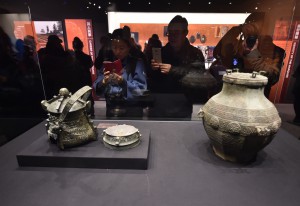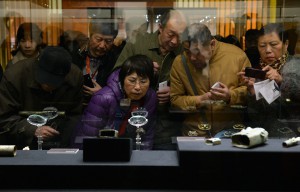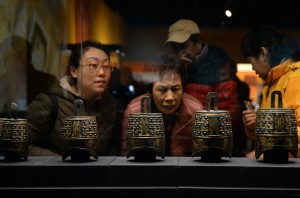北欧绿色邮报网报道(编辑陈雪霏)--中国女足胜韩国队。3月7日,中国女足队员与主教练布鲁诺(中)在比赛获胜后走向球迷。
当日,在日本大阪举行的2016年里约奥运会女足亚洲区预选赛决赛阶段第四轮比赛中,中国队以1比0战胜韩国队。
Daily Archives: 03/18/2016
图片新闻--足球——女足奥预赛:中国队胜日本队
图片新闻:汉代海昏侯墓441组件文物亮相首都博物馆
American travel market eyes Chinese tourists
BEIJING, March 18(Greenpost) — If there was just one thing the world’s two largest economies could agree on both wanting, tourism would be it.
China and the United States announced this week in Beijing that 2016 will be the year of mutual tourism promotion, one of the outcomes of President Xi Jinping’s visit to the United States last year.
The focus on tourism between the two countries come as overseas travel booms in China, in fact more Chinese vacation abroad than any other nation. More than 120 million Chinese traveled abroad last year, up 12 percent year on year, and they spent 104.5 U.S. billion dollars, up 16.7 percent over the same period.
“The scale and the speed with which the market [has] grow[n] is quite remarkable,” said Fred Dixon, CEO of NYC & Co., the agency responsible for promoting New York City, the top U.S. destination city for Chinese travelers.
Despite New York being the top destination less than 3 percent of Chinese outbound tourists go to the United States. The Republic of Korea, Japan and Thailand are much more popular choices, partly because of their proximity.
Despite this, Chinese visitors to the United States has been growing at a double digit rate over the past few years.
In 2015, 2.67 million Chinese visited the United States, compared with less than 400,000 in 2007. Goldman Sachs estimates that the number of Chinese visitors will almost double to 5 million by 2025.
This growth prospect has excited tourism players across the States. Many have sent delegations to China and the news about the tourism exchange will no doubt see them double down their promotional efforts.
Dixon said his organization’s budget for promoting New York inChina has risen in recent years, and is outpacing growth of marketing expenditure for other destinations.
Travel agencies and tourism promoters say a more powerful boost to Chinese tourists inflow to the U.S. is visa relaxation. In November 2014, the two countries extended visa validity for tourists from one to 10 years.
This policy has pushed up the share of Chinese travelling to the United States purely for leisure. Data compiled by various popular destination cities in the United States show that for Chinese visitors, leisure travelers have begun to outnumber business travelers in many places.
“The 10 year visa extension is really a game changer,” Dixon said, adding that the relaxation has paved the way for more Chinese to visit the United States for pure leisure and on their own, instead of on business trips or organized group tours.
Chinese online travel service provider Ctrip also reported a surge in U.S. visa application through its platform between January to August last year following the visa relaxation.
With more tourists heading to American shores on their own, tourism promoters say they are reviewing their messages here in China. While travel agencies are still valuable partners, they have begun to engage with prospective travellers directly.
“In the very beginning our work was very much about working closely with the trade [travel agencies] on the group side, but now we are seeing a move toward independent travel,” Dixon said.
That shift led promoters to prioritize their online presence, as websites, social media and apps have become prime channels for information and planning.
More than 259 million Chinese booked their travel online last year, of which 80 percent did so on their mobile devices, according to ChinaInternet Network Information Center.
The demographics are changing too. China’s outbound travel boom is fueled mostly by a new generation of travelers. 67 percent of China’s overseas tourists in 2014 were born after 1980s, data compiled by Goldman Sachs show.
All these changes impact travel decisions. Promoters say group travelers want to see iconic sites and things they have seen on TV and in the movies. But reaching out to the new generation of savvy Chinese outbound travelers takes more than that.
The appeal for them, Dixon said, lies beneath the surface, in lesser known communities, parks and museums that add more personal character to their travel experience.
“This is an exciting time,” he said. “You don’t often see a market emerge the way China has. And we probably won’t see anything like this again.” Enditem
Source: Xinhua
China’s environment for foreign investors improves, not worsens: spokesman
BEIJING, March 2 (Xinhua) — China’s business environment for foreigners has improved, not worsened, Wang Guoqing, spokesman for the annual session of the Chinese political advisory body, said Wednesday.
The Chinese government is firmly determined to build an internationalized environment featuring the rule of law and facilitation for foreign investment, Wang said at a press conference in Beijing.
“I believe China will continue to be the world’s popular destination of investment and profit can be made here,” said Wang, spokesman for the Fourth Session of the 12th National Committee of the Chinese People’s Political Consultative Conference. Enditem
China extends fishing ban on Yangtze River
WUHAN, March 1 (Greenpost) — The Chinese Ministry of Agriculture has activated an annual fishing ban along the Yangtze River, starting March 1.
The ban, which lasts until June 30, covers the spawning season for most of the river’s aquatic life. It will include the entire river as well as key tributaries and lakes.
The ban also applies to the Huaihe River, which runs almost parallel between the Yangtze River and the Yellow River.
The ban has been extended by one month, from three months to four, in a bid to better protect fish resources, said Li Yanliang, director of the ministry’s Fishery Inspection and Management Office.
“The extension marks a new phase for environmental protection along the river as the central government starts intensive efforts to protect the Yangtze,” Li said.
The first ban on the lower reaches of the river was in 2002. In 2003, it was approved by the State Council and extended to the whole river basin.
The Yangtze is regarded as a cradle of China’s freshwater fish species and a valuable reserve of aquatic biodiversity. However, excessive fishing has put some species on the brink of extinction.
Last week, China vowed to improve the water quality of the Yangtze as part of wider measures to balance economic activity and environmental protection.
In the years leading up to 2020, China will work to ensure that more than 75 percent of the water in the Yangtze economic belt, covering 11 provinces and municipalities, meets at least the Grade III standard, according to the National Development and Reform Commission (NDRC), the top economic planning agency.
China classifies water quality into six levels, ranging from level I, which is suitable for drinking after minimal treatment, to level VI, which is severely contaminated.
The NDRC said China aims to bring more than 97 percent of water from sources along the Yangtze belt up to Grade III before 2020. Enditem
Source Xinhua
China to unveil retirement age plan in 2016: official
BEIJING, March. 17 (Xinhua) — China will release a plan on raising the retirement age this year to cope with pressures from a shrinking work force and an aging society, an official said on Monday.
The official retirement age, which was adopted six decades ago when life expectancy was much lower, has not adapted to economic and social development, said Yin Weimin, minister of human resources and social security, at a press conference.
China’s retirement age is 60 for men, 55 for female white-collar workers and 50 for female blue-collar employees.
The retirement ages in developed countries mostly range from 60 to 65, and even older in some countries, said Yin, adding it has been common practice to raise the retirement age worldwide.
“We’ve already worked out a plan to postpone the retirement age, but it should be approved by the authorities before being released to solicit public opinion,” he said.
The policy changes in retirement age will be phased in over a long period of time, with only slight annual increases, Yin said, adding the adjustment will take into consideration different groups of workers.
China is facing great challenges in dealing with a soaring senior population. The number of people aged 60 or over reached 212 million last year, accounting for 16 percent of the country’s population. Enditem
Source Xinhua
Editor Xuefei Chen Axelsson










 新华社记者马平摄
新华社记者马平摄











 新华社记者马平摄
新华社记者马平摄









